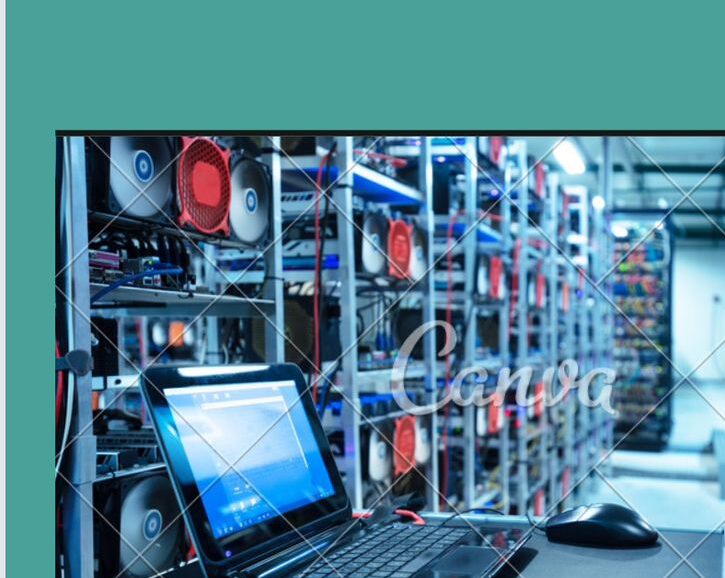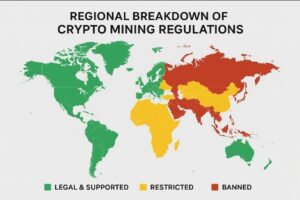
Bitcoin mining might sound like digital gold digging, but it’s actually the backbone of the entire Bitcoin network. Every transaction you make with Bitcoin depends on miners working around the clock to keep the system secure and functional.
Think of Bitcoin miners as the accountants of the cryptocurrency world. They verify transactions, prevent fraud, and get paid in Bitcoin for their efforts. But instead of using calculators and spreadsheets, they use powerful computers to solve complex mathematical puzzles.
What Exactly Is Bitcoin Mining?
Bitcoin mining is the process of creating new bitcoins while simultaneously verifying transactions on the network. Miners use specialized computers to solve extremely complicated math problems that validate blocks of transactions.
When a miner successfully solves one of these puzzles, two important things happen. First, they add a new block of verified transactions to the blockchain. Second, they receive a reward of newly created bitcoins plus transaction fees from users.
The mining process serves multiple critical functions for Bitcoin. It introduces new bitcoins into circulation at a predictable rate. Then, It secures the network against fraudulent transactions and double-spending. It maintains the decentralized nature of Bitcoin by allowing anyone with the right equipment to participate.
Currently, miners receive 3.125 bitcoins for each block they successfully mine. At Bitcoin’s recent price of over $100,000, that’s more than $300,000 per block. However, this reward gets cut in half approximately every four years in an event called “halving.”
The Step-by-Step Mining Process
The mining process begins when users make Bitcoin transactions. These transactions first go to a waiting area called the mempool. Think of it as a pool of pending transactions waiting to be confirmed.
Miners select transactions from the mempool to create a new block. They typically prioritize transactions with higher fees since these increase their profits. Each block can only hold a limited number of transactions, creating competition among users who want faster confirmations.
Next comes the computational heavy lifting. Miners must find a special number called a “nonce” that, when combined with the block’s data and run through a cryptographic function, produces a specific result. This result must meet the network’s current difficulty requirements.
The process works like a massive guessing game. Miners try billions or even trillions of different nonce values per second. Modern mining equipment can perform over 300 trillion attempts per second. The first miner to find the correct nonce broadcasts their solution to the network.
Other nodes on the network then verify the solution. If everything checks out, the new block gets added to the blockchain. The winning miner receives their reward, and the process starts again for the next block.
Essential Mining Equipment and Tools
Gone are the days when you could mine Bitcoin with a regular computer. Today’s mining requires specialized hardware called ASICs (Application-Specific Integrated Circuits). These machines do one thing exceptionally well: solve Bitcoin’s mining puzzles.
A competitive ASIC miner costs between $10,000 and $20,000. The most powerful models can perform over 300 terahashes per second while consuming significant amounts of electricity. For perspective, that’s 300 trillion attempts at solving the mining puzzle every single second.
Beyond hardware, miners need reliable internet connections and access to cheap electricity. Electricity costs often determine whether mining is profitable. A single ASIC can consume as much power as a small house, running 24/7.
Mining software connects your hardware to the Bitcoin network. For example, popular options include CGMiner, BFGMiner, and EasyMiner. These programs manage the mining process and display important statistics like hash rate and temperature.
As a result, most individual miners join mining pools to increase their chances of earning rewards. Pools combine the computational power of many miners and, in turn, share rewards based on each member’s contribution. Notably, major pools include Foundry USA, AntPool, and F2Pool.
Understanding Bitcoin Mining Rewards and Profitability
Bitcoin mining profitability depends on three main factors: hardware efficiency, electricity costs, and Bitcoin’s market price. The delicate balance between these elements determines whether mining generates profits or losses.
The block reward started at 50 bitcoins in 2009 and halves every four years. After the most recent halving in April 2024, miners now receive 3.125 bitcoins per block. The next halving in 2028 will reduce this to 1.5625 bitcoins.
Transaction fees provide additional income for miners. During busy network periods, fees can add thousands of dollars to each block’s total reward. As block rewards decrease over time, transaction fees will become increasingly important for miner compensation.
Mining difficulty adjusts every 2,016 blocks (roughly two weeks) to maintain consistent block times. When more miners join the network, difficulty increases. When miners leave, difficulty decreases. This self-regulating mechanism keeps new blocks appearing approximately every 10 minutes.
Calculating profitability requires careful consideration of all costs and revenues. Online mining calculators can help estimate potential returns based on your hardware, electricity rates, and current network conditions.
Environmental Impact and Future Considerations
Bitcoin mining consumes enormous amounts of electricity, estimated at over 120 terawatt-hours annually. That’s comparable to the entire electricity consumption of countries like Argentina or Norway.
This energy consumption has sparked environmental concerns and regulatory responses. Some countries have banned mining entirely, while others have introduced special taxes on mining operations. Sweden increased taxes on cryptocurrency mining by 6,000%, effectively making it unprofitable.
The future of Bitcoin mining likely involves continued technological advancement, increased energy efficiency, and, moreover, greater integration with renewable energy infrastructure.
Additionally, as regulatory frameworks evolve, miners may need to adapt to new compliance standards. Understanding these trends, therefore, helps investors and participants make informed decisions about their involvement in the Bitcoin ecosystem. Furthermore, as the industry matures, collaboration between stakeholders may become increasingly essential. Ultimately, these developments could shape a more sustainable and secure mining landscape.

